Future-proofing talent: Redesigning jobs and HR in Singapore

In the first part of the interview, Julia Ng, Assistant Chief Executive of Workforce Singapore (WSG), explored the pressing talent challenges faced by employers in Singapore and highlighted the role of Job Redesign Centre of Excellence (JRCoE) in supporting organisations on their workforce transformation journey.
Building on those insights, this second part delves deeper into the practical aspects of job redesign, skills-based hiring, and talent retention strategies, as Ng shared valuable advice with HRM Asia on how organisations can adapt their HR practices to create a more agile and future-proof workforce.
Can you elaborate on your definition of job redesign?
Ng: Job redesign refers to the restructuring of work tasks and responsibilities to optimise processes and workforce allocation for improved productivity, and to better support business transformation priorities. It aims to create higher value jobs that are more fulfilling for employees and that contribute more effectively to the business priorities.
Job redesign supports business transformation in several ways, such as:
-
-
- Improved productivity and cost savings: Job redesign can help streamline work processes and reduce costs by optimising the workforce and minimising non-value-added activities.
- Improved ability to attract and retain talent: By redesigning jobs to better fit employees’ interests and abilities, businesses can improve job satisfaction and employee engagement. This better enables businesses to attract and retain talent amidst a manpower shortage.
- Increased agility to respond to changes in the market and achieve better customer satisfaction: By redesigning jobs, businesses can optimise their workforce to better harness new business models and technologies. These new business models can help businesses pivot and adapt to new market conditions, while technology adoption can help businesses automate processes and increase efficiency. When such business transformation efforts are complemented by workforce transformation via job redesign, businesses can become more agile in responding to changes in the business environment and the requirements of their customers, leading to enhanced customer satisfaction and competitiveness.
-

“By redesigning jobs, businesses can optimise their workforce to better harness new business models and technologies. These new business models can help businesses pivot and adapt to new market conditions.” – Julia Ng, Assistant Chief Executive, Workforce Singapore
On the employee front, job redesign can benefit them in the form of:
-
-
- Enhanced skills and career development: Job redesign can provide opportunities for employees to develop new skills and take on new responsibilities, which can potentially lead to better career development and advancement opportunities.
- Better job satisfaction and improved employee engagement: Job redesign can lead to greater job satisfaction by providing employees with more autonomy and exposure to new areas of work. This can lead to a greater sense of fulfilment and purpose in the work they do.
-
How can organisations shift to assessing and hiring based on diverse skills rather than relying solely on qualifications or past experiences?
Ng: To move towards skills-based hiring, employers will need to change their mindsets from “plug-and-play” to “plug-train-play” to widen access to talents. They should also be prepared to make adjustments to existing recruitment and hiring practices.
They will need to first conduct a comprehensive skills mapping exercise to identify the specific skills and competencies needed for the roles in their workforce. The Jobs Transformation Maps (JTM) provide a good resource for employers to glean insights on how technology as well as global and local trends will impact job roles and skills, and the skills and talent that they will need to remain competitive.
When recruiting, instead of solely focusing on qualifications or past experiences, employers should then assess candidates based on whether they have the required skills and competencies that were identified for those roles. Candidates can validate their skills through certifications, online courses, or assessments.
Employers should also consider a candidate’s potential, skills adjacencies, adaptability, and capacity to learn and look beyond traditional credentials to identify individuals who may bring unique perspectives and skills to the organisation. This can be done through interviews that focus on how candidates have applied their skills in real-world situations, which provides insights into their problem-solving abilities, interpersonal skills, and overall suitability for the role.
For example, when considering a mid-career individual, look at how they can bring in fresh perspective and novel approaches to problem-solving through skills-based assessment or practical case studies. Mid-career individuals often bring a wealth of diverse perspectives and experiences gained from working across different industries or roles. This can contribute to innovative problem-solving and a broader range of ideas within the organisation, thereby fostering a culture of creativity and continuous improvement. While specific industry knowledge may differ, mid-career individuals also bring with them transferable skills such as effective communication, project management, leadership, and teamwork which could be of value to the organisation. In addition, such mid-career individuals may have developed mentoring and coaching abilities over time. As such, they can contribute to the growth and development of younger team members, fostering a collaborative and supportive work environment.
What are some of the HR practices that they can adopt to enhance talent retention and career mobility within their organisation?
Ng: To enhance talent retention and improve the career mobility of employees, employers should establish clear career paths within the organisation and work with employees to set personalised development plans that align with their skills, interest and career goals. This clarity can enhance motivation and engagement. They can also implement mentorship programmes to connect experienced employees with those seeking guidance. This helps in knowledge transfer, skill development, and provides a support system for career growth.
More importantly, employers should provide ongoing training and development opportunities, including workshops and online courses, to help employees acquire new skills and stay relevant in their roles. Employers can tap on Workforce Singapore’s Career Conversion Programme, which allows new mid-career individuals and existing employees to undergo skills conversion and move into new sectors or redesigned job roles that have good prospects and opportunities for progression. Salary support of up to 90% is given to new hires and/or existing employees.
READ MORE: Building a future-ready workforce to address talent challenges
Employers who are keen to embark on job redesign can also tap on Workforce Singapore’s Support for Job Redesign under Productivity Solutions Grant (PSG-JR) which provides funding support of up to 70% for job redesign consultancy support. Other available workforce development and job redesign support provided by Workforce Singapore can be found on our website.



